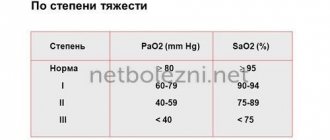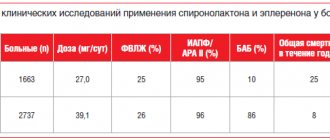In practice, the New York Heart Association (NYHA) classification is often used to assess the severity of heart failure:
I class
— Physical activity is not limited
Class II
— Mild limitation of activity.
The appearance of shortness of breath and weakness after moderate physical activity. Class III
- Marked limitation of activity.
Shortness of breath after minimal physical activity Class IV
- Severe limitation of activity. Symptoms of heart failure at rest
NYHA classification
In
Russian practice it is used together with the above. In addition to dividing into stages, functional classes of chronic heart failure are distinguished based on exercise tolerance:
- FC I - the patient has no restrictions on physical activity. Habitual loads do not cause pathological symptoms (weakness, shortness of breath, pressing pain, palpitations);
- FC II - load limitation is assessed as “moderate”. There are no signs of pathology at rest, but performing normal physical activity becomes impossible due to palpitations, shortness of breath, anginal pain, and a feeling of lightheadedness;
- FC III - “pronounced” limitation of exercise, symptoms are relieved only with rest, and performing even less physical activity than usual provokes the appearance of clinical signs of the disease (weakness, angina, shortness of breath, interruptions in heart function);
- FC IV - inability to tolerate even the slightest (everyday) physical activity, that is, intolerance to it. Discomfort and pathological symptoms are caused by activities such as washing, shaving, etc. Also, signs of heart failure or pressing chest pain can occur at rest.
These two classifications relate to each other as follows:
- CHF stage I - NYHA functional class 1
- CHF stage II A - NYHA functional class 2–3
- CHF II B - Stage III - NYHA FC 4
Reasons for development
Chronic heart failure occurs against the background of other diseases that affect the myocardium and blood vessels. Therefore, it is always necessary to treat or keep primary diseases under medical supervision, as well as monitor the condition of your circulatory system.
Factors in the development of CHF
- Arterial hypertension (AH) is the main cause of chronic heart failure.
- Coronary heart disease (CHD) is in second place among the provoking factors.
- Cardiomyopathies (including those provoked by infectious diseases, diabetes mellitus, hypokalemia, etc.).
- Valvular (mitral, aortic, tricuspid, pulmonary) and congenital heart defects.
- Arrhythmias (tachyarrhythmias, bradyarrhythmias).
- Diseases of the pericardium and endocardium.
- Conduction disturbances (antrioventricular block).
- High load (for example, with anemia).
- Volume overload (eg, renal failure).
The course of any disease from the list above should be monitored by the attending physician
Classification of heart failure
Classification of heart failure is carried out according to clinical signs, namely the ability to adequately tolerate physical activity and the symptoms that arise during this.
The classification made it possible to have a unified approach to diagnosis, as well as, more importantly, treatment of this condition. The first classification dates back to 1935, its authors were Soviet cardiologists N.D. Strazhesko and V.Kh. Vasilenko. For a long time it remained the only one, but in 1964 the NYHA (New York Heart Association) classification was adopted in New York. Cardiologists determined the functional classes of CHF on it.
Strazhesko-Vasilenko classification (with the participation of G. F. Lang)
Was
adopted at the XII Congress of Therapists of the USSR. Classification of CHF is carried out in 3 stages:
- Stage I - initial. It is characterized by the fact that hemodynamic disorders are compensated and are detected only with significant physical activity (domestic) or stress tests - treadmill, Master's test, bicycle ergometry (during diagnosis).
Clinical manifestations: shortness of breath, palpitations, fatigue at rest disappear;
- Stage II - severe heart failure. When it occurs, hemodynamics are disrupted (stagnation of blood in the circulatory system), the ability to work is sharply impaired, tissues and organs do not receive the required amount of oxygen. Symptoms occur at rest. It is divided into 2 periods - IIA and IIB. The difference between them: at stage A there is failure of either the left or right parts of the heart, when at stage B there is total heart failure - biventricular;
Stage IIA - characterized by stagnation in the pulmonary or systemic circulation.
At this stage of heart failure, in the first case, left ventricular failure occurs. It has the following clinical manifestations: complaints of shortness of breath, cough with the release of “rusty” sputum, suffocation (usually at night) as a manifestation of the so-called cardiac asthma.
When examining, pay attention to pallor, cyanosis of the extremities, tip of the nose, lips (acrocyanosis). There is no swelling. The liver is not enlarged. On auscultation, you can hear dry rales; with severe congestion, signs of pulmonary edema (fine-bubble rales).
When cardiac function is impaired with the development of stagnation of the systemic circulation, patients complain of heaviness in the right hypochondrium, thirst, swelling, abdominal distension, and indigestion.
There is cyanosis of the face, swelling of the veins of the neck, external edema (later - cavitary edema: ascites, hydrothorax), enlarged liver, heart rhythm disturbances. Treatment at this stage may be especially effective.
- How long can you live with stage 1 chronic heart failure?
Stage IIB - represents total heart failure with severe manifestations of circulatory failure. Combines symptoms of blood stasis BCC and MCC. This stage is very rarely reversible.
Stage III - final stage, heart failure in the decompensation stage. Deep myocardial degeneration occurs, irreversibly damaging both the heart itself and the organs experiencing ischemia and oxygen starvation due to its dysfunction. It is terminal and never undergoes regression.
The mechanism of pathology formation
Chronic cardiovascular failure develops slowly due to the body's compensatory mechanisms.
At the compensatory stage of the myocardium, the heart muscle begins to hypertrophy. The vessels expand, causing their walls to become more fragile and permeable over time. Hormones are produced that change the composition of the blood, which becomes more liquid, its volume increases due to increased work of the bone marrow and an increase in the amount of water due to retention.
Compensatory possibilities dry up, and the decompensatory stage begins, which is characterized by a weakening of the functions of the entire cardiovascular system.
As the muscle mass of the myocardium grows, its small vessels lag behind in development, as a result, the heart muscle lacks oxygen and nutrients. Pathological changes occur: the proliferation of connective and sclerotic tissue. The heart becomes unable to pump the increasing volume of blood. Extensive oxygen starvation begins, which covers all organs.
Along with this, the walls of blood vessels become more fragile and permeable. Lymph leaks from the vessels. Swelling begins. These phenomena are especially dangerous in the lungs. They quickly fill with liquid and stretch. A person is tormented by a severe cough, and the discharge of sputum does not provide relief.
CHF according to Vasilenko-Strazhesko (stages 1, 2, 3)
The classification was adopted in 1935 and is still used today with some clarifications and additions. Based on the clinical manifestations of the disease during CHF, three stages are distinguished:
- I. Latent circulatory failure without concomitant hemodynamic disorders. Symptoms of hypoxia appear with unusual or prolonged physical activity. Possible shortness of breath, severe fatigue, tachycardia. There are two periods, A and B. Stage Ia is a preclinical variant of the course, in which cardiac dysfunction has almost no effect on the patient’s well-being. Instrumental examination reveals an increase in ejection fraction during physical activity. At stage 1b (latent CHF), circulatory failure manifests itself during physical activity and goes away at rest.
- II. In one or both circles of blood circulation, stagnation is expressed that does not go away at rest. Period A (stage 2a, clinically pronounced CHF) is characterized by symptoms of blood stagnation in one of the blood circulation.
- III. The final stage of the disease with signs of failure of both ventricles. Against the background of venous stagnation, severe hypoxia of organs and tissues appears in both circulation circles. Multiple organ failure and severe swelling develop, including ascites and hydrothorax. Stage 3a is treatable; with adequate complex therapy for CHF, partial restoration of the functions of the affected organs, stabilization of blood circulation and partial elimination of congestion are possible. Stage IIIb is characterized by irreversible changes in metabolism in the affected tissues, accompanied by structural and functional disorders.
The use of modern drugs and aggressive treatment methods quite often eliminates the symptoms of CHF corresponding to stage 2b to a preclinical state.
Acute form
Along with chronic, there is an acute form of heart failure. The reasons for its occurrence are:
- myocardial infarction;
- major stroke;
- structural defects of the heart, congenital and acquired;
- hypertension.
A distinctive feature of acute cardiovascular failure is the suddenness of the attack and the absence of the listed stages of development. The person's condition quickly deteriorates and death is possible within a few minutes. The occurrence of pathology is indicated by a sharp deterioration in condition, suffocation, severe cough with foam or red sputum, blue discoloration of the skin, and cold sweat.
In such cases, first aid is to call an ambulance. Then the victim should be taken out into the open air, the collar and other tight clothing should be unbuttoned. The best pose is considered to be sitting, with legs down. A nitroglycerin tablet should be given under the tongue. Repeat the dose every 10 minutes until the ambulance arrives.
Important! In acute heart failure, you should not take a supine position.
The meaning of CHF classification
Assigning a patient's status to a certain stage of CHF is important for selecting therapy, assessing its results, as well as predicting disease outcomes.
For example, stage I chronic heart failure certainly requires the use of fewer drugs and, conversely, stage III CHF forces the cardiologist to prescribe 4–5 groups of drugs. Assessing the dynamics of the functional class of circulatory failure is important, again, for selecting therapy, following a diet, and prescribing a rational motor regimen. The value of classifying the patient’s status for prognosis can be characterized by the following statistics: annually, 10% of patients die from heart failure in FC 1, approximately 20% in FC 2, about 40% in FC 3, and in FC 4, the annual mortality rate exceeds 65%.
- Diagnosis and treatment of chronic heart failure today
Age and gender factor
Statistical studies prove the connection between the spread of the disease and the gender and age of the patient.
In the age group up to 65 years, women suffer from congestive heart failure to a lesser extent; above this age, the rates become equal. Death as a result of acute heart failure is recorded in men after 45 years.
In old age, symptoms of congestive heart failure are more common, this is explained by chronic diseases, poor lifestyle, and reduced immunity.







